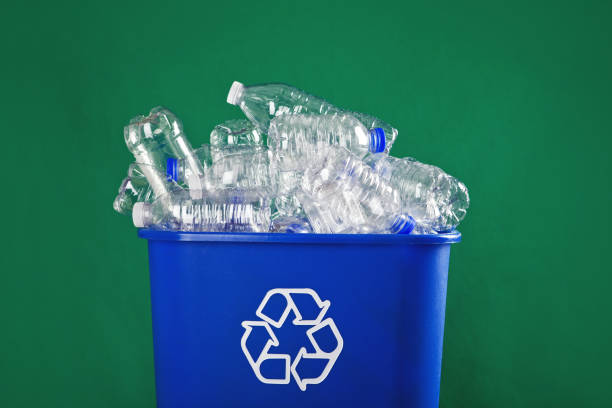Is my recycling actually getting recycled at CU Anschutz?
Apr 7, 2025
The short answer is “yes”, but
the longer answer is “it’s complicated”. Impressively, the CU Anschutz campus
sends over 1.6 million pounds of waste to be recycled by Republic Services. However,
whether your plastic bottle is sorted, shredded, melted, and reformed back into
another bottle is a complicated question to answer. To understand, we need to take
a step back and look at the life cycle of a package from cradle to grave. This
means that we must observe the different stages of the package’s supply chain
from when it was created to all the way past the time of disposal. There are
decisions that are made along the way that impact a package’s recyclability. Let’s use plastic bottles as an example.
A Brief Overview of the Supply
Chain
Upstream
“Upstream” refers to the processes
in the supply chain that occur before a complete product is created, such as
sourcing materials, transportation, product planning and design, and
manufacturing. When a manufacturer creates a new bottle, the plastic resin is refined
from oil, or the plastic is sourced from a recycler. A brand’s packaging engineers
and marketing team plans and designs how the plastic bottle should look and
function. Then, the manufacturer takes the plastic materials and converts them
into the brand’s bottle design. For example, the Heinz brand’s team partners
with a manufacturer to create a ketchup bottle that has an opaque red PET plastic
body. Aquafina will design a water bottle to have a clear PET plastic body. While
both bottles are made of the same PET plastic, only one of these will get
recycled. The decision by Heinz to dye the plastic an opaque red renders the bottle
unrecyclable. Why? Recyclers sort all the plastic material they receive by
color, resin type, weight and other characteristics. Certain colors and resins
are highly sought after by bottle manufacturers, thus making those high-demand
materials very valuable. In the case of the Heinz ketchup bottle, the opaque
red color is undesirable by manufacturers, thus it has no value to the
recycler. Low value material is not worth the time, effort and money to clean
and prepare for sale, so this red opaque plastic goes to the landfill. In other
words, there is not a large market for the purchase of red opaque PET plastic,
thereby resulting in the recyclers being unable to sell this material to be
turned into a new bottle. This is an example of a decision that was made
upstream, before the product even reaches your hands, that deems the package
unrecyclable.
If you’re interested in diving deeper into sustainable
packaging design and its influence on recyclability, check out this
article that’s full of great examples where brands choose materials to
reduce environmental impact.
Pictured:
The bottle on the left is opaque red PET plastic whereas
the
bottle on the right is clear PET plastic.
Downstream
“Downstream” refers to the
operations and movement of finished products to the end consumer; In the
recycling supply chain, the end consumer is the recycler. Two common downstream
operations that affect recyclability: 1) Behavior at the point of material
collection and 2) the infrastructure and machinery involved in the sortation of
materials. Sometimes recycling requires more than just getting your plastic
bottle into the correct bin. The bottle may need to be cleaned, emptied, or
even altered for the recycler’s machinery at the Material Recovery Facility
(MRF) to properly capture the material.
In the example of a plastic
bottle, the way the bottle is prepared before being placed in the recycling bin
is a common point where recyclability is affected. For example, if your water
bottle is half full or if you forgot to remove a sleeve-like label, then the
bottle will not be recycled. These two examples change how the plastic gets
sorted by a recycler’s machinery at their MRF. In the first example, the
unfinished water affects the weight of the plastic bottle, thus causing the
package to be improperly sorted. Similarly, in the second example, the
sleeve-like label could be made of PP plastic resin while the bottle underneath
is made of PET resin. The recycling machinery will recognize the package by the
outer label, thus sorting the bottle into the incorrect material pile. However,
if you make sure the bottle is completely empty and the sleeve-like label is
removed, then the plastic bottle will be properly recycled. You may see
custodial staff throwing seemingly recyclable materials into the garbage;
however, this is likely stuff that is not prepared properly for recycling. Overall,
recycling works, but it would be more effective if there was increased synergy
throughout the supply chain.
If you’d like to better understand how a Materials Recovery
Facility operates, check out this
video.
Pictured:
Example of on-pack recycling education where
the
consumer is instructed to remove the sleeve label.
CU Anschutz’s Role in Recycling
The challenges to recycling exist
up and down the supply chain. Decisions made in packaging design or how someone
interacts with a package could affect its recyclability. While CU Anschutz
cannot control many upstream and downstream choices, there is still an
important and impactful role to play in this supply chain.
CU Anschutz offers single stream
recycling, which means that students, faculty, staff and visitors on campus
have access to recycle plastic, paper, cans and glass via any bin labeled for
recycling. However, we recognize the large unmet opportunity to provide better
signage and education on how to properly prepare your waste to be recycled. The
Sustainability Team has plans to address this over the next year – Stay tuned!
When it comes to the question “Is
my recycling actually getting recycled at CU Anschutz?”, the answer is “Yes”. We
play an important part in the supply chain by offering access to recycling
services and we are also working to expand educational signage on how to
recycle.
Got questions? Email me! Julianna.nienart@cuanschutz.edu